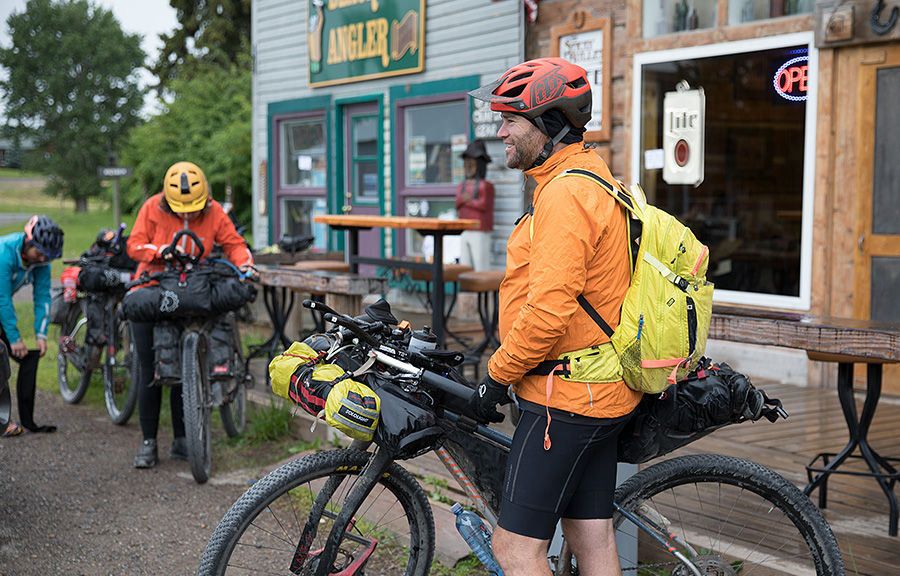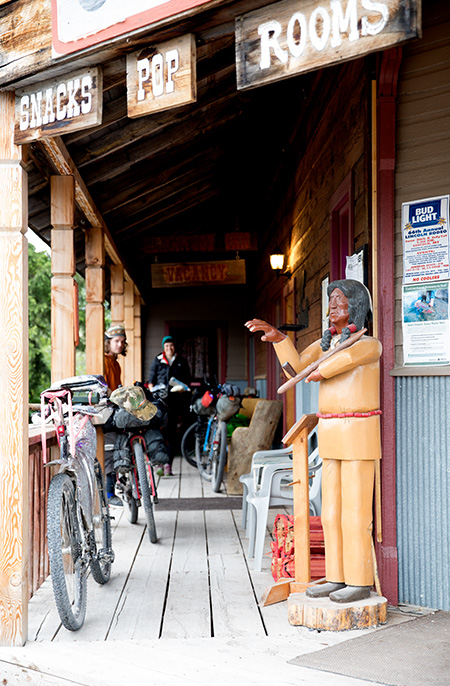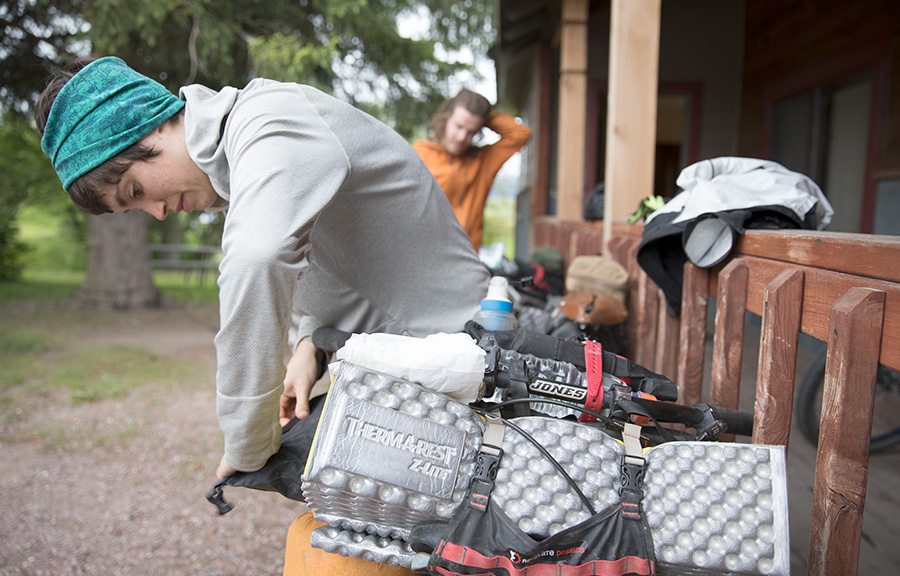Ultralight Touring: A Primer
A typical bicycle traveler loads their bike up with front and rear racks, four panniers, a handlebar bag, and then often lashes a tent and other gear — pillow, family pet, etc. — to their rear rack. Some riders even use both a loaded trailer and panniers for their travels. Of course, you can ride with whatever you want — if it makes you happy, take shoes for any occasion and the living room couch. It’s possible to ride with an amazing amount of weight on your bike.
There is, however, another way.
Thanks to a new generation of incredibly light equipment and the pioneering strategies of ultralight backpackers, it’s now possible for the modern velo-adventurer to leave the panniers and trailers at home and travel with a base gear weight of fifteen pounds or less. (Base gear weight includes all gear and gear carriers, but not food, water, and the base set of clothes on your body.) For road cyclists, this can mean easier, more enjoyable riding, free from the overburdened pack-mule effect of traditional touring. For mountain bikers, it’s a true revelation — they can now head out on singletrack or jeep roads and ride for days on end with very little weight or performance penalty. The exploration and adventure potential is off the charts. We’re not sure what charts, but if anybody keeps adventure-potential charts, it’s way off those.
What follows is a discussion of gear and strategies for lightening your touring load. Different people may take these ideas further than others, and hardcore ultralight techniques may not be for everyone. Cyclists heading out for very long rides — say across the country or around the world — may want more camp luxuries, more clothes, and the most durable gear possible. Adopt the strategies and ideas that are right for you. Surely, some self-supported cyclist, somewhere, has already taken their base gear weight below ten pounds, while others have no desire to carry less than thirty. Just remember that all the heavy stuff that makes camp-life more comfortable is a lot less comfortable when you’re lugging it over a mountain pass. By only bringing what’s necessary, and making that as light as possible, you can have a much more enjoyable ride.
Just remember that all the heavy stuff that makes camp-life more comfortable is a lot less comfortable when you’re lugging it over a mountain pass.

Basic Gear Strategy
Many ultralight backpackers use silnylon tarps (silnylon is silicone impregnated ripstop nylon that is waterproof and very, very light) or waterproof bivy sacks for shelter, but there are also several lightweight tents on the market that work great and become even lighter when used in their “fast-fly” or “fly and floor” configuration. Used this way, the tent body is left at home and only the fly and ground tarp are used. See the packing list for more ideas. As a general guideline, you want to keep your tent weight at or below two-and-a-half pounds per person.
For sleeping bags, look for ones with 800-fill down and half-length zippers. Several companies make these bags with temperature ratings between thirty and forty degrees that weigh about a pound. Again, check out our packing list. You shouldn’t have any problem finding a good summer bag that weighs less than a pound-and-a-half. You can also get very comfortable sleeping pads that weigh about a pound and pack small. For minimalists, there are pads in the eight-to-twelve-ounce range that also work well. Diehard ultralighters even use Mylar-coated bubble wrap as sleeping pads. Mike Curiak set the record time for the Great Divide Race using a car windshield shade as a sleeping pad.
For clothes, focus on the essentials. Choose riding clothes you can wear in town without needing to change. Bring a rain jacket and pants (these needn’t weigh more than ten-to-twelve ounces each, and can be used at night as camp-wear) and a set of long underwear. A down vest or jacket makes a perfect final, lightweight insulation piece and packs down small. Choose comfortable shoes that you can wear in camp or out to eat, and bring flip-flops if you need more footwear. Look at the packing list for cooking- and water-system ideas.
Carrying Your Stuff
How you carry your stuff is critical to keeping your load light. Panniers and trailers can be quite portly and doing without them can save you a lot of weight. Revelate Designs makes top-quality handlebar, seat, frame, and cockpit bags that fit almost any bicycle.
If you’re not ready to spend the money on custom bags, you can try putting your gear in a waterproof stuff or compression sack and lashing it to a rack. Old Man Mountain racks are tough and fit on virtually any bike. A handlebar bag, seat bag, or frame bag can hold other gear. If you do use panniers try using only a front pair. If you’re traveling light, it’s all you need.

A Few Words about Food
If you’re the eating type, you’ll want some food on your trip. The thing to look at is your food’s calorie-to-weight ratio. Most people don’t want to geek-out and spend too much time doing this, so here are a few basic strategies to consider.
- Fat is your friend. You burn a lot of calories on bike trips and nothing packs in calories for the weight like good, old-fashioned fat. If you’re riding hard, you’re metabolism will churn right through it. Just make sure it’s good fat.
- Nuts and nut butters are wonderful things. They pack a ton of calories for their weight and are healthy. Most natural food stores sell bulk nut-mixes in several thousand varieties that make great trail food. Nut butter can be packed in light, plastic squeeze-tubes available at outdoor shops and spread on crackers for a high-calorie lunch or snacks (bread is heavy and low in calories).
- Oatmeal is the breakfast of champions. The little instant packets you can get at any grocery store are light, fast-cooking, and pack lots of complex carbohydrates for sustained energy.
- Freeze-dried backpacking food is still probably the best way to go for dinners. Jerky can also be a light, high-quality protein source.

Tips for Off-road Riding
- If your route includes lots of climbing, consider getting lower gears. On steep trails, the added weight of your gear can make 11-22 gearing inadequate. A twenty-tooth front chainring can make all the difference.
- Try a handlebar bag of some kind. With the added weight on the rear of your bike, it can be trickier keeping your front-end on the ground during steep climbing. A handlebar bag of some kind can help. Jandd makes some that work well.
Multi-time Tour Divide Champion Matthew Lee’s Tips
- Bring all the allen wrenches you’ll need separately, as opposed to on a multi-tool. They’re easier to work with and can actually be lighter. Most bikes don’t have a need for a six millimeter.
- Bring a separate chain-tool. The chain-tools on multi-tools are harder to use and more likely to fail.
- Rather than carrying heavy electrolyte-replacement-drink powder, try Elete electrolyte drops.
- A pair of medical-grade scissors are light, cut through virtually anything, and come in handy more than you might imagine.
- Super glue has a million uses. Bring it on every multi-day ride.
- Glue thin strips of closed-cell foam (you can get it from paddling stores) to your rear rack to prevent from rubbing holes and abrasions through lightweight stuff sacks on long rides.


